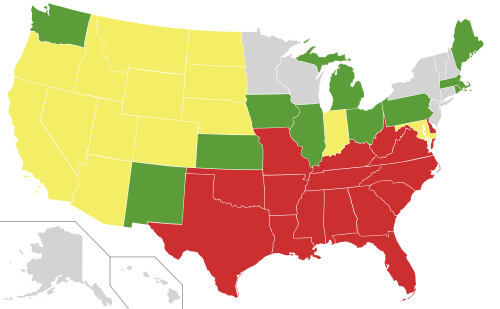While watching the documentary Freedom Riders with my middle school students last week, one of them stumped me with a great question: was there racial segregation in Connecticut? This led the class on a broad fact-finding mission where we learned some positive and negative things about our state’s history. Here are a few of the highlights:
- ConnecticutHistory.org says that in spite of Connecticut’s Gradual Emancipation Act of 1784, there were enslaved people here as late as 1848! Didn’t expect that one… For more on slavery in Connecticut, read here.
- Conversely, Connecticut was also home to many stops on the Underground Railroad.
- In 1818, the Connecticut Voting Law disenfranchised free black men who had not voted before. This law was in effect until after the end of the Civil War.
- On a better note, Connecticut was one of only nine states that never outlawed interracial marriages.
U.S States, by the date of repeal of anti-miscegenation laws:
No laws passed
Repealed before 1887
Repealed from 1948 to 1967
Overturned on 12 June 1967 by Loving v. Virginia decision
“US miscegenation” by Certes – Vector map from Blank US Map.svg. Information from Anti-miscegenation_laws. Licensed under CC BY 3.0 via Wikimedia Commons.
- Also, Connecticut has never had a lynching – of either a black or white person.
- Fast forwarding to modern times… In landmark case Sheff v. O’Neill, the Connecticut Supreme Court decided in favor of urban plaintiffs – saying that the racial homogeneity of the Hartford School system amounted to school segregation, hence violating Brown v. Board of Education.
- As a result of the 1996 Sheff decision, 47.5% of Hartford students now attend racially integrated schools. According to the Hartford Courant, “It is the second year in a row that the percentage of children in integrated settings has exceeded the target set by the Sheff case. Last year’s target was 41 percent, and 42.4 percent of Hartford students were reported in integrated settings.” But Connecticut is still home to some of the most segregated schools in the nation.
To learn more about the history of racial segregation in different states, check out some cool interactive maps on PBS. Happily, the maps make Connecticut look pretty good in comparison to, say, Mississippi – where there were 539 documented lynchings of blacks and 42 lynchings of whites between 1882 and 1968. That’s more than one every two months for an eighty-six year period…
I wouldn’t be a good teacher if I didn’t close with an “exit ticket” — comment below and let me know what surprised you in this article.



Jessie,
Like your middle school students, my Trinity College students have puzzled over this question about racial segregation in Connecticut, and published essays in ConnecticutHistory.org to share what they’ve found:
http://connecticuthistory.org/trinity-college-students-call-attention-to-histories-of-inequality/
See more in our book-in-progress:
http://OnTheLine.trincoll.edu
Jack Dougherty, Trinity College